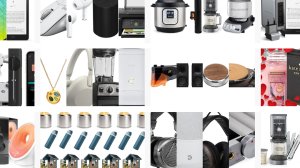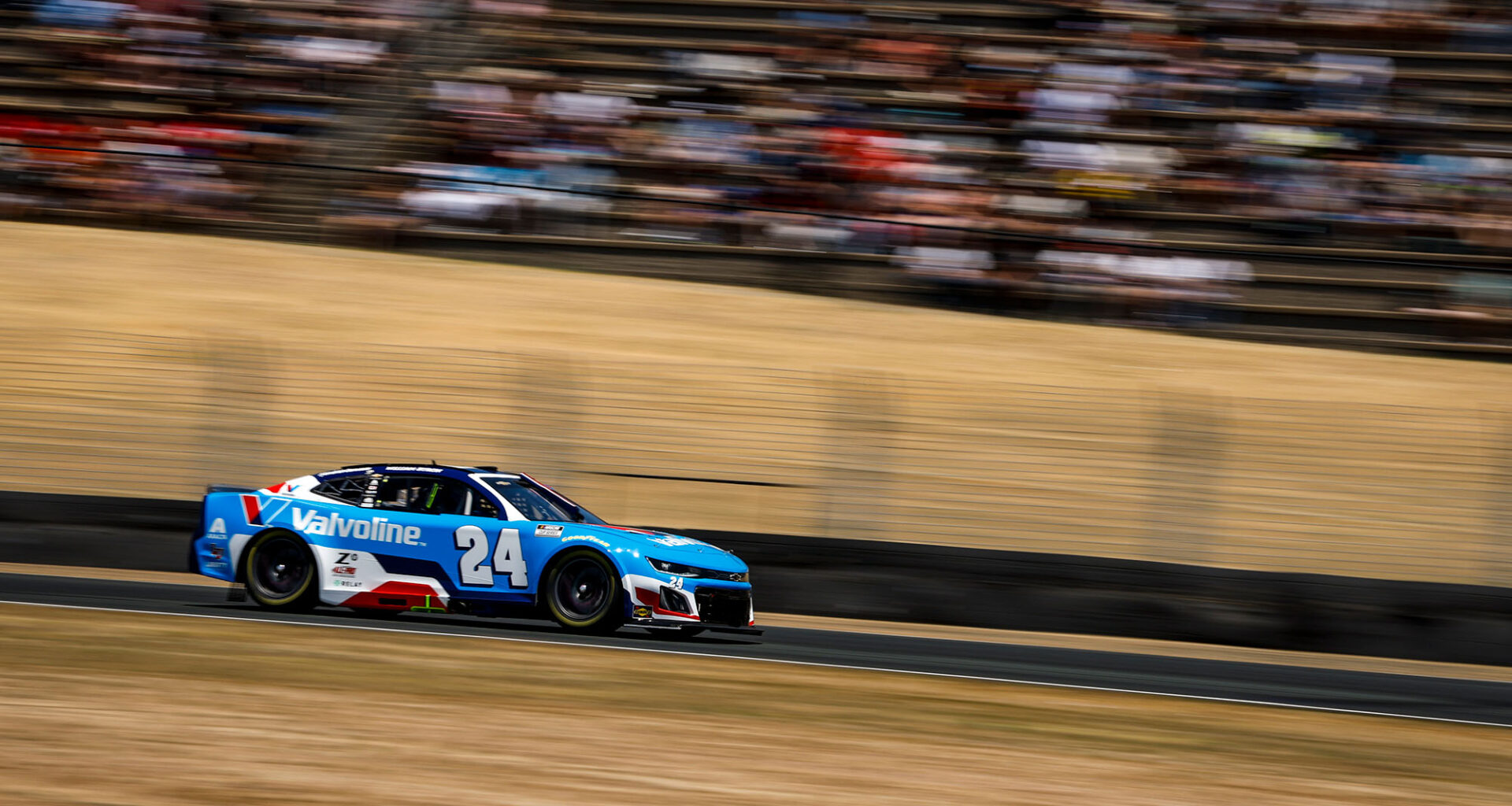Sign Up For Goods 🛍️
Product news, reviews, and must-have deals.
A tire is making decent progress coming out of a turn at Sonoma Raceway—except for the fact it’s no longer attached to Cody Ware’s No. 51 Ford Mustang. Crowds gasp, cars swerve, and the wheel menacingly rolls off, then on, and then off the track again before it finally collapses.
I’ve never related to a tire more. Everyone’s had that kind of year at least once, and here I was watching the phrase “when the wheels come off” taken literally. And this wasn’t the only mishap. Multiple caution flags flew late in the NASCAR Cup Series race in July, each a reminder of how thin the line is between control and chaos.
From my perch outside the Hendrick Motorsports suite, I looked out across the 12-turn, nearly 2-mile road course that demands everything from a team: uphill climbs, blind downhill plunges, sharp switchbacks, and punishing braking zones.
Every race is a lesson in control and recovery. Some factors—the car’s line through turns and the fluids coursing through the engine—can be fine-tuned. Others—a rogue tire or a collision—can only be endured. The difference comes from how much advantage you wring out of the controllables, and how quickly you restore after the rest. That’s the mindset behind Valvoline’s Restore & Protect motor oil.
The fluid advantage
The Valvoline logo splashes across the hood of Hendrick Motorsports’ No. 24 Chevrolet, driven by the unconventional William Byron. At just 27, he’s already a two-time Daytona 500 winner, and his path to NASCAR’s top tier started in front of a screen, logging thousands of iRacing laps before ever climbing into a stock car.
The fans at Sonoma want to experience more than monitors, however. They come for the drivers and the front-row view of the surprisingly athletic pit crews, doing push-ups to warm up pre-race before swapping four tires and refueling in mere seconds. Tucked in the towers, however, engineers stare at a wall of displays, parsing mountains of telemetry to find an edge.
In stock car racing, there’s only so much a team can change. Engines, chassis, body parts, fuel and fuel systems, and tires are all tightly regulated. Not fluids, though. That’s where Valvoline gives Byron and the Hendrick Motorsports team a decisive performance lever. When margins are measured in thousandths of a second, a few percentage points less wear, a fraction of a degree more heat resistance, an oil blend that cleans instead of clogs—those could be the difference between running in the pack and crossing the line first.
“If you follow NASCAR, you find out Hendrick is a little bit faster than everybody else,” Roger England, Valvoline’s chief technology officer, told me. “And we like to think we have a hand in that.”
And it’s not just NASCAR. In drag racing, Valvoline crafts high-viscosity blends that can withstand the intense conditions of a top fuel dragster—an engine so extreme that even 70-weight oil is good for only one ride. In Formula One, the company has recently teamed up with Aston Martin to develop brake and shock fluids that can withstand the intense heat and pressure of hybrid engines racing around Monaco.
“I am a very competitive person, and our team is very competitive. We want to win every week. We want to dominate, and we’re willing to do the work to do that,” England said.
The Ph.D. pit crew
England is as passionate about product innovation as he is about racing, and sports a wardrobe of classic mechanic’s shirts to prove it. He can toggle from chemistry equations to racing anecdotes without missing a beat. And don’t even get him started on oxidation.
“We’ve got about 11 engineers just on the racing side, plus technicians, plus people from all over Valvoline,” England said. “If you add us all together in tenure, my technical team has over a thousand years at Valvoline. That gives us a lot of stability—and it means we can try some pretty cutting-edge things.”
This collection of geeks, nerds, Ph.D.s, and motorheads—England’s terms of endearment—can use Valvoline’s global operations to keep their latest projects away from prying eyes. Molecules can be modeled and synthesized in Mumbai, India, scaled into full products in Lexington, Kentucky, and tested in vehicles, test stands, or EV drive cells in Ashland, Kentucky—all without leaving the Valvoline fence line.
But collaboration matters just as much. Valvoline’s innovation engine spans divisions, including passenger cars, heavy-duty trucks, and race cars. Engineers swap ideas constantly, sometimes literally walking a new tweak down the hall to the racing group for a quick test. England said that openness keeps the culture from growing complacent. “We’re never arrogant enough to think we have all the ideas,” he told me. “We’ll try anything. Because the only thing better than being arrogant is winning.”
That drive to win has carried Valvoline into arenas most fans wouldn’t connect with the brand. The company is working with the Mahindra Racing Formula E team—yes, that’s all-electric racing—to turn fluid chemistry into on-track advantage by addressing the specific high-speed lubrication, thermal management, and electrical insulation challenges of electrical components. Behind the scenes, Valvoline has also become a tier-one supplier for EV driveline fluids and built a 500-kilowatt-hour “virtual battery wall” to eliminate the variability of real batteries in fatigue and performance testing.
And the same fight against heat extends far beyond vehicles. Data centers—already enormous power hogs—are becoming even hungrier as artificial intelligence drives new demand. Cooling those racks of processors is as critical as cooling an engine at 9,000 RPM, and Valvoline’s team has been developing advanced fluids for high-performance computing to do just that. The goal is the same: control heat, reduce wear, and extend machine life.
From race car to minivan
All that innovation filters down to consumers. For Valvoline, Restore & Protect is the product that best captures what its engineers have learned under the pressures of racing and beyond (earning it a Business Intelligence Group Innovation Award since its January 2024 introduction).
England is quick to point out that oil isn’t just “slippery stuff.” It has five jobs inside an engine: lubricate, seal, protect, cool, and clean. “Restore & Protect features clean, but it’s still good at all the rest,” he said. “It’s like a rock band. You’ve got all the players, and you decide who to feature.”
That emphasis on “clean” is what sets the formula apart. For years, industry tests simply tried to slow the growth of carbon buildup. Valvoline pushed further to remove it.“We can take a crappy old engine with a lot of carbon, run our oil in it, and it will clean it up, seal again, and restore it to what it was,” England explained.
It’s the latest chapter in a long line of innovation: Valvoline was the first company to bring racing oil to market, the first with high-mileage oil, and now the first with a formula designed not just to protect but to restore. And for drivers who may never see the inside of a NASCAR pit, the result is engines that run longer, cleaner, and stronger—or at least devoid of that puff of troublesome blue smoke from the muffler.
Back at Sonoma Raceway, the Hendrick Motorsports team has mixed results. Byron fought back from a tough pit stop to finish eighth, banking valuable playoff points. Teammate Chase Elliott surged late, using a clever tire strategy to secure third. Alex Bowman came home 19th, narrowly missing advancement in NASCAR’s In-Season Challenge, while Kyle Larson’s race unraveled in a pair of late crashes, leaving him 35th.
It was a day that showed both the fragility and resilience of racing. Fortunes can change on a pit stop, a tire choice, a caution flag, or a brush with traffic. Engines get torn down and rebuilt, data gets pored over, fluids get tested and refined. Restore, protect, repeat. Those fluid-aided fractions of a second adding up, Byron went on to win the 2025 Regular Season Championship and sits second in the playoffs after New Hampshire.
England wouldn’t have it any other way. “I have a good time,” he told me, smiling. “I enjoy my job. I do. It’s freaking fun.” And maybe that’s the heart of it. Restore & Protect is a reminder, not just a product pitch. Racing—and life—isn’t about avoiding chaos. That’s impossible. It’s about how you learn and return after the wheels come off.

More deals, reviews, and buying guides
The PopSci team has tested hundreds of products and spent thousands of hours trying to find the best gear and gadgets you can buy.
